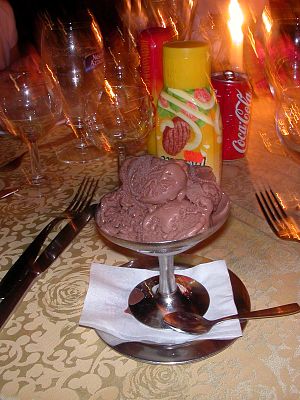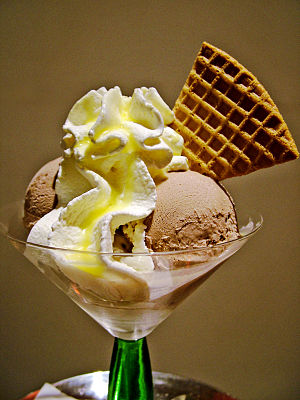Gelato

Gelato is an Italian frozen dessert made from milk (or also soy milk) and sugar, combined with other flavourings. The gelato ingredients (after an optional pasteurisation) are super-cooled while stirring to break up ice crystals as they form. Like high end ice cream, gelato generally has less than 35% air - resulting in a dense and extremely flavorful product.
Gelato has become a generic Italian word for ice cream, though true gelato contains no cream. The same word is commonly used in English speaking countries to refer to "ice cream" that is prepared in the Italian way. Gelato comes from the Italian word gelare, meaning "to freeze."
Overview
Gelato is typically made with some fresh fruit or other ingredients such as chocolate (pure chocolate, flakes, chips, candies, truffles, etc.), nuts, small candies, sweets, or cookies. Outside Italy it is often made using fruit pastes imported from Italy. Gelato made with water and without dairy ingredients is also known as sorbetto.
Dairy gelato is made with whole cow's milk and contains 4–8% fat depending on the ingredients (nuts, milk, or cream would increase the fat content). North American-style ice creams contain more fat than gelato, ranging from 10% to 18% since more cream is used. Like high-end ice cream, good quality gelato combines high quality ingredients with milk and cream, soy milk, or water. Gelato is usually made with whole milk which is 3 - 4% butterfat - and often cream is added to raise the fat level. Unlike ice cream, gelato ingredients are not homogenized together, and the result is a thinner consistency than ice cream as the product melts.
Some gelato recipes call for eggs, although with the homogenisation of the Italian gelato culture and mixes and stabilisers readily available and in use, eggs are being phased out as emulsifiers.
Gelato is served from a different freezer than American style ice cream - a forced air freezer - which is usually held at about -15°C (5 - 8°F). This allows the gelato to be served immediately after being extruded from the gelato machine - the "forced air" blowing around holds the product at a consistent temperature. The best gelato is made fresh daily. Much of the gelato experience is in its semi frozen consistency, therefore, you may serve ice cream from a gelato freezer but you may not serve gelato from an ice cream freezer - the gelato would become too frozen.
Other countries make ice creams similar to gelato - in Argentina, helado is made much the same way. And in France, though usually slightly higher in fat, Glace is a very similar product and, in fact, was introduced to France by Catherine De' Medici (of Florence).
Some Italian food products use gelato as a main ingredient. These may include ice cream cake, semifreddos (gelato cake), spumoni, cassate, tartufo and fruit-filled gelato candies and mignon.
Traditional flavors

- Chocolate
- Bacio (chocolate and hazelnut)
- Hazelnut
- Pistachio
- Stracciatella (vanilla and chocolate) with nuts covered in sugar
- Strawberry
- Lemon
Recipe
The recipe for a gelato of fruit is:
- 1/3 sugar
- 1/3 milk
- 1/3 fruit
Nothing else. The way the fruit is added depends on the kind of fruit. If it's like lemon or orange, add only the juice; if it's like banana or peach, peel it, remove the stone (if any) and blend it; if it's like strawberry or cherry, just remove the stone (if any) and blend. According to the sweetness of the fruit, the quantity of sugar can be sightly increased or decreased. For other tastes without fruit, the recipe becomes more complicated
It is common for a producer to use different ingredients for several reason:
- instead of fresh ingredients, powdered milk, fruit concentrates and other sweeteners (such as glucose) can be used to save money
- stabilisers and conservatives can be added to make it last longer
- colourants can be added to make it look nicer
Notable gelaterias
North America
America - Western States
- Alotta Gelato, Silver City, New Mexico.
- Angel Sweet Chandler, Arizona.
- Frost Gelato Tucson, Arizona.
- Gelateria Naia, Berkeley, California.
- Gelato Classico, San Francisco, California.
- Gelatomania Santa Cruz, California.
- Gelato Milano, Berkeley, California.
- La Gelateria, Honolulu, Hawaii.
- Sketch, Berkeley, California.
- Tango Gelato, San Francisco, California.
- Mio Gelato, Portland, Oregon.
America - Midwestern States
- Gelatida Minneapolis, MN
- Cerrone Gelato,Illinois.
- Divino Gelato Cafe, Waukesha, Wisconsin.
- The Gelateria, Saint Louis, Missouri.
- Istria Cafe, Chicago, Illinois.
- Gelato Da Vinci, Carmel,Indiana.
- La Gelateria, Cleveland Heights, Ohio.
- Paciugo Gelato, Dallas, Texas.
- Piccomolo Italian Ice Cream, Colleyville, Texas.
- Vucciria, Milwaukee, Wisconsin.
America - Eastern States
- Angelato, Belmont, Massachusetts.
- GS Gelato, Ft. Walton Beach, Florida.
- Dolce Crema, Moorestown, New Jersey.
- San Gelato Cafe, San Destin, Florida.
- Capogiro Gelato, Philadelphia, Pennsylvania.
- Ciao Bella, New York City, New York.
- Gelato Dream, Fort Lauderdale, Florida
- Splendoras Gelato Cafe, Charlottesville, Virginia.
- Libby's, New Haven, Connecticut
Canada
- Coppa Di Gelato, London, Ontario.
- La Casa Gelato, Vancouver, British Columbia.
- Mondo Gelato, Vancouver, British Columbia.
- Fiasco Gelato, Calgary, Alberta
Europe
- Della Palma, Rome, Italy.
- Fantasia, Naples, Italy.
- Gelati d’Alberto, Paris, France.
- Giolitti, Rome.
- Il Gelato di San Crispino, Rome.
- Pellacchia, Rome.
- Vivolo, Florence, Italy.
Australia
- Bar Italia, Sydney, Australia.
- Gelatissimo, Sydney, Australia.
- Mondo Gelato, Sydney, Australia.

